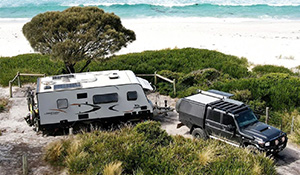TECH - Odyssey 21
Photos: Extreme E
Brought to you by Castrol EDGE
The worlds of motorsport and environmentalism are usually at odds with one another, but Extreme E is aiming to bring the two together by creating a sustainable, environmentally responsible EV racing series and taking it to parts of the world most at threat from climate change.

Now in its second season, Extreme E is an FIA-sanctioned international motorsport series that, in its simplest terms, is an off-road equivalent of the Formula E electric open-wheeler racing category that’s been running since 2014.
Several elements set Extreme E apart from other motorsport, though.

Extreme E Primer
For starters, Extreme E not a spectator sport in the traditional sense, as the races are all held in remote areas, deliberately chosen for their susceptibility to damage from climate change or already impacted by it. By bringing the races to these areas, Extreme E aims to highlight environmental issues in these areas, supplemented by a science and research group that travel with the teams to study the impacts of climate change and implement programmes that can be used to positive effect by locals.

With no “in person” fans, the races are all broadcast online.
Secondly, the races themselves are short and sharp, consisting of only two laps over a course that’s approximately 7km in length and very loosely laid out, allowing a diversity of lines and paths to be taken. Given the aforementioned remote areas where each round is held, there’s no “track” to follow, so drivers have to find the lines that work best during qualifying and the races, sometimes following others, while plotting their own course at other times.

Dust, rain and mud have an impact, and of course, as the tracks rut up, the best lines change, making the racing more dynamic. To add some spice into the mix, gradients have featured at most rounds, too, which push the capabilities of the electric racers.

Ten teams make up the entry list, each of which has a male and female driver. Both drivers spend equal time in the car across the race formats, which have a knockout element in qualifying and semi-finals to determine a grid for the final. The top two finishers in each of the two semi-finals progress to the final, but the wildcard in Extreme E is the ‘crazy race’ that allows a fifth and final team that missed the cut in the semis to grid up for the final, too.
The two-lap final includes a driver change, aka the “switch”, after lap one. As in other forms of motorsport, the winner of the final accrues the most points, but these go to the team, rather than the individual.

Odyssey for All
Extreme E is a one-make series, with all teams in the same spec cars that have a common chassis, drivetrain and other equipment. The racers look like a mix between Dakar racer and off-road buggy, which makes sense given the racing is conducted exclusively off tarmac.

Named ‘Odyssey 21’, these racers were developed by UK firm Spark Racing Technology and consist of a niobium-reinforced steel alloy frame combining the roll cage and mounting points for the drivetrain, suspension and wheels in one unit. Niobium is an element already in use in sections of the automotive industry, but was chosen for Extreme E because it’s more sustainable than other metals.

Cladding this chassis is a bodyshell made from natural flax fibre, which again, was chosen for its environmental credentials in being more sustainable than carbon fibre, fibreglass and other materials. The benefits of this flax fibre material, developed by a company called Bcomp, include a claimed 75 per cent reduction in carbon footprint compared to existing materials, while offering the same weight, strength and safety properties. Each Odyssey 21 vehicle weighs 1870kg unladen.

While the bodyshell is common to all, Extreme E rules allow for modification, which some teams have already implemented, but these are more for commercial reasons than any performance advantage. For example, the Ganassi Racing Team has remodelled their Odyssey 21 bodywork to resemble the Hummer EV of team partners GMC.
Each Odyssey 21 measures 4.4 metres long, 2.3 metres wide and 1.86 metres high, with a 3.0 metre wheelbase. Front and rear track is almost 2 metres, with ground clearance of 450mm.

Suspension front and rear is made up of double wishbones with three-way adjustable dampers that deliver up to 385mm of travel. Heavy duty iron disc brakes with six-piston calipers feature on all four wheels.
Power for the Odyssey 21 consists of a pair of electric motors producing up to 470kW. Even though Extreme E isn’t about raw speed – tactics and racecraft play just as big a role – top speed of 200km/h is achievable. Each vehicle can hit 100km/h from a standstill in 4.5 seconds and climb gradients of up to 53 degrees, depending on the surface.

To boost performance within a race, each Odyssey 21 has a “Hyperdrive” function that delivers an additional shot of EV power, but this can be activated only once per lap. As Hyperdrive only increases power for five seconds, choosing when and where to activate it on a lap is another tactical decision.

Batteries developed for the Extreme E buggies by Williams Advanced Engineering deliver 54kWh in this application and use technology that will also be applied to the Gen3 Formula E racers next year.

The final piece of the Odyssey 21 is its tyres, which were developed specifically for the vehicle by Continental. Unlike other motorsport categories that offer a variety of hard and soft compounds, as well as grooved and slick tyres, there’s only one spec of tyre for Extreme E, but the compound and tread pattern produced by Continental is designed to handle a variety of conditions.
Keeping the sustainability theme going, teams are allocated only one set of new tyres per race, but can select two used tyres as well. This allows for punctures and other damage that’s inevitable in off-road competition.

The Racing
The initial season of Extreme E last year attracted some heavy hitters in the world of motorsport, including Formula One World Champions Lewis Hamilton, Nico Rosberg and Jenson Button, who signed up as team owners, while the driving talent reads like a who’s who of past Dakar winners and contenders, with Nasser Al-Attiyah, Carlos Sainz, Jutta Kleinschmidt and Sebastien Loeb on the roster, to name a few.

Last year, former Australian Rally Champion Molly Taylor partnered with Johan Kristoffersson in Rosberg’s RXR squad to win the inaugural Extreme E championship, but is not contesting this year’s series. There is an antipodean connection, though, with McLaren Racing signing up for the second season and kiwi rallying star Emma Gilmour one of the team’s two drivers.
(NOTE: JUST CARS has more on Emma Gilmour and her signing with McLaren’s Extreme E squad).

Second Season, Same Result?
At time of writing, after three of five rounds, RXR leads the 2022 Extreme E championship and seem all but certain of making it back-to-back titles.
You can follow the progress of this year’s Extreme E championship and find out more about the teams, drivers and environmentally sustainable approach that’s driving this EV off-road series at: extreme-e.com









